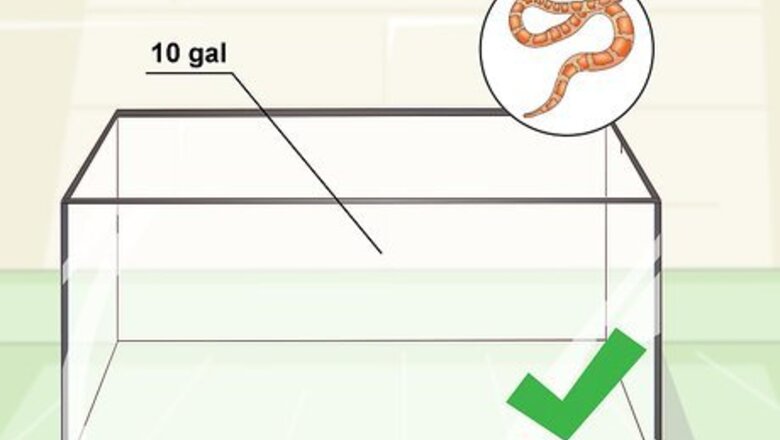
views
Providing a Clean and Comfortable Habitat
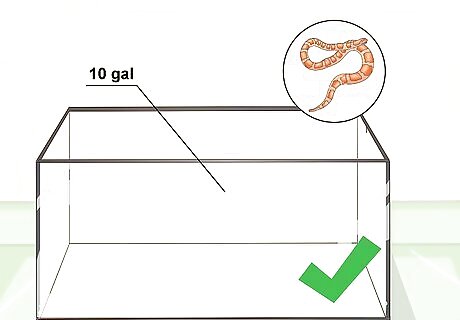
Create the right habitat. For babies, a 10 gallon (37.9 L) tank with a heating pad under 1/3 of the tank is perfect. If you choose to house a baby in a larger aquarium, include many more hide boxes to make it feel more secure. Set this up several days before getting your snake so that the temperature can regulate. When a corn snake is purchased as a baby, place it in a small vivarium and increase vivarium sizes as the snake grows. If a small baby is placed into a large vivarium straight away, it will become territorial and strike at anyone who goes near it and will most likely bite them. Keeping the babies in a small vivarium also makes sure the babies can readily find the food you place in there for them. Keep only one snake per tank because they may become hostile if kept together.
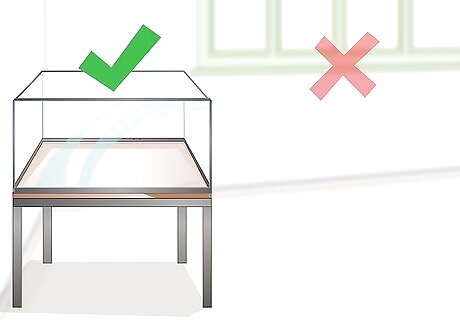
Decide where you will set up your vivarium. For easy access and viewing, place it high enough to look in, but low enough you can reach into it. Do not place tank near a window or other drafty area, as this can affect the temperature too much. Also, keep in mind that you should place your snake's home somewhere where it will not be disturbed by other pets or small children.
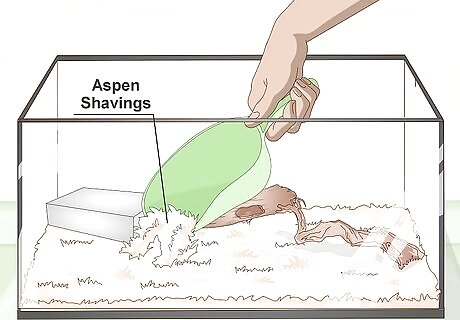
Fill the tank with substrate. You will need to put aspen shavings or similar bedding in your snake's tank. at least two hides (one dry and one moist for shedding), and decorative plants. Aspen substrate is best, though cypress mulch also works. Do not use pine, cedar, soil, or bark as substrates, as they are very fragrant.
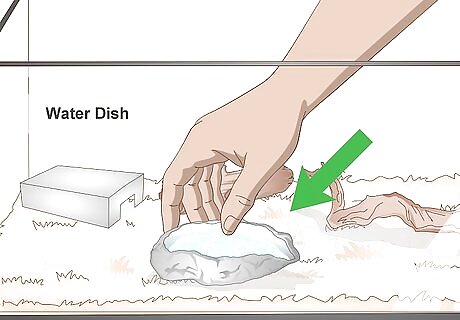
Put a water dish in the tank. It is important to include a dish of water containing clean water in your snake's tank. Use a water dish that's a bit heavy, so your snake will not tip over the water bowl. The water should be changed every day.

Place your snake gently in the tank. Once you purchase a baby corn snake you should get it into its new home as quickly as possible. Try not to handle the snake, however, so just release it into the tank. Lift the cover off its travel container and setting the container in the tank, allowing the snake to come out in its own time. Handling can cause the snake stress and it will already be stressed from traveling to its new home.

Clean the tank regularly. Spot clean your tank to remove feces as soon as it appears. However, you should also do a full clean once every two weeks to a month, depending on your snake's size and the amount of waste it produces. To clean the tank, you will need to remove the snake temporarily. Remove all substrate, clean all items that need to go back in the tank, and then put new substrate and cleaned items back in the tank once it is dry.
Feeding Your Snake
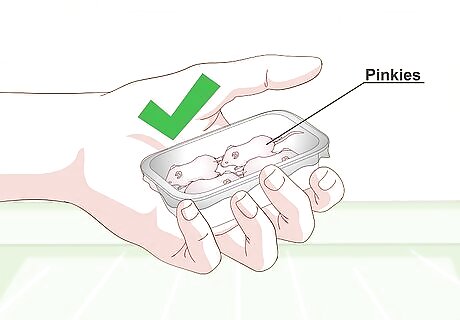
Obtain "pinkies." Pinkies are dead mice that were only a day to a week old. They are available at most pet stores and can be ordered online from reptile suppliers. Make sure that you are getting small pinkies, as baby corn snakes need a smaller pinkie than older snakes. Buying frozen mice in bulk can save you money. Make sure to thoroughly thaw the mice before leaving them for your snake. Never feed live food to your snake. The live food can harm your snake and potentially kill it. Also, feeding live animals to snakes in the UK is illegal.

Decide where to feed your snake. Some people who have snakes simply feed them in their tank. Others prefer to feed their snakes in feeding tubes outside of their tanks, which are typically just plastic tubs that are lined with paper towels. The idea behind this option is that if the snakes are never fed in their tanks, then they will bite less often. A hand going into the tank will never be assumed to be food, as the snake will never have been fed in the tank. Additionally, some argue that the snake can ingest substrate if it is fed in its tank. This can cause a snake digestive problems.
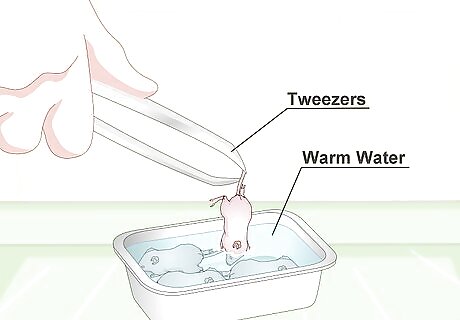
Prepare the snake's food. Warm the pinkie if it is frozen. Put it into a plastic bag and then into warm water and wait for it to fully defrost. When it is defrosted, dry it off with a paper towel and then pick it up by the tail with tweezers. Don't put it straight into the water because it will cook and may harm the snake . The pinkie doesn't need to be totally warm but it should not be frozen when you offer it to your snake. Rinse the pinkie to remove any off-putting taste or odor that will turn your snake off. Increase the size of the mouse as the snake grows, never feed a pinkie wider than your snake is at that time.
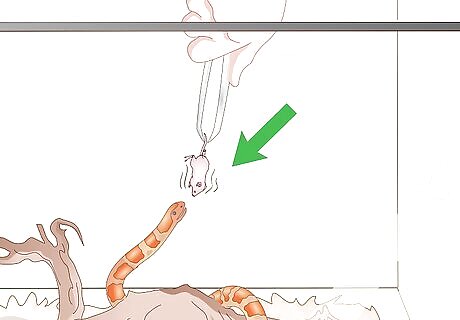
Offer the snake its food. Place the mouse nose-to-nose with the snake. Slightly shake the tweezers you are holding it with to catch the snakes attention. If your snake is hungry, it should begin to bite the pinkie. When the snake strikes, let go of the mouse and allow the snake to swallow it.

Feed your snake one mouse every week. Baby cornsnakes will need to be fed every 5 to 7 day to keep them healthy. You should see whether your corn snake seems interested in food after 5 days have elapsed by dangling a pinkie in front of it. If the snake is interested, give it the food. The prey item should be at least as wide as your snakes thickest body section but can be up to 1.5 times bigger. If the prey item is small compared to your snake, feed it two. If it is larger, feed it one. Adult cornsnakes should be fed every 7 to 10 days. They are no longer growing, so they need fewer calories to thrive. Corn snakes will overeat if you offer them more food.
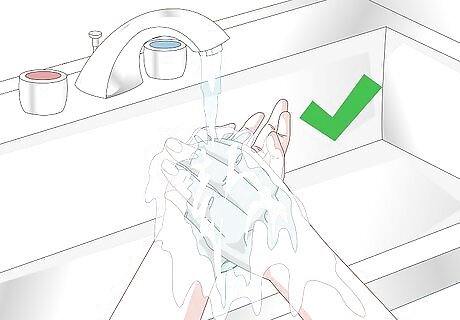
Make sure you wash your hands after feeding. Always use antibacterial soap or hand gel before and after holding your snake and before and after feeding it. This will help to stop bacteria and parasites, like salmonella, from spreading. Washing your hands when you are interacting with your snake is very important. It helps to protect your health, as well as the health of your snake.
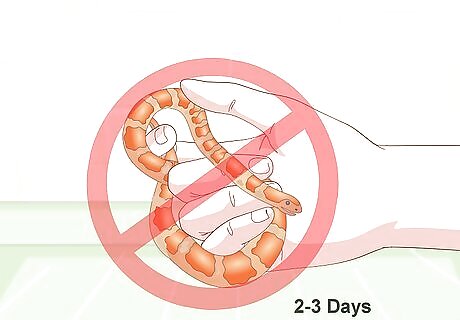
Do not handle the snake after feeding. Wait 2-3 days after feeding to handle the snake. Your snake will need some time and privacy to properly digest its food. If you feed your snake in a feeding tub, simply pick up the tub after the snake begins digesting its meal and allow the snake to reenter its tank without being handled.
Keeping Your Snake Healthy
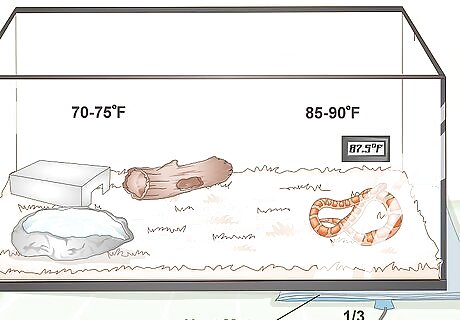
Provide a temperature gradient by placing a heat mat under the cage. Corn snakes ONLY need belly heat. Snakes in the wild do not bask they hide most of the day so they do not benefit from a basking lamp like lizards do.You will want to place a heating pad under about 1/3 of the aquarium. This will give your snake a side of its tank that is warmer and a side that is cooler. The temperature should be 85-90 on the warm end and 70-75 on the cool end. Place a thermometer inside the enclosure so that you can monitor the temperature. Your snake will tell you if the hot spot(s) are too warm - if your snake is always pushed against one area away from the hot spot, this is a sign it’s too warm and you should turn the heat lamp down.
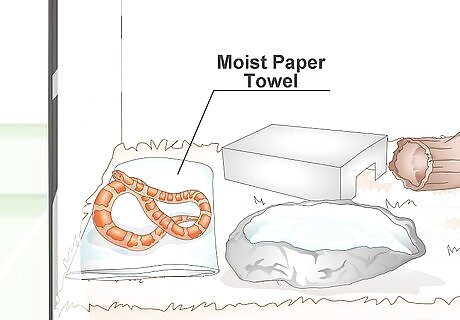
Give your snake a moist area. Your snake should have access to a moist area when it is shedding. Do not raise the humidity of the entire tank, as this can cause respiratory infections. However, you should put a moist paper towel or moist moss in an area to give it some moisture. Corn snakes are not tropical and do not need raised humidity.

Pick up your snake at its center. When picking up your snake, scoop it up at the center of its body. Don't pinch or grab it. Picking it up improperly can injure the snake or can cause the snake to bite. You should approach the snake from the side when picking it up. This will be less stressful for the snake, as approaches from the top are similar to predator attacks. Try using a snake hook if you are afraid to pick up your snake. This is less stressful for both you and the snake and helps keep you from getting bitten. Be aware that the snake may bite when you try to pick it up, especially when you are first beginning to hold it. Corn snakes are great snakes for beginners due to their docile nature, but they can still bite. After you have one hand under the belly, you can place your second hand behind the head gently to keep control of it.




















Comments
0 comment